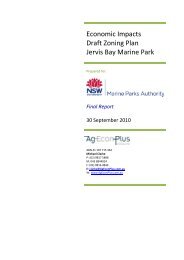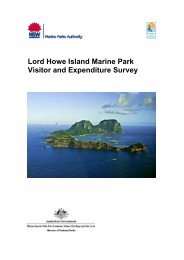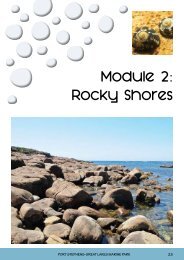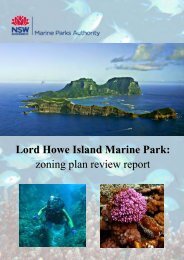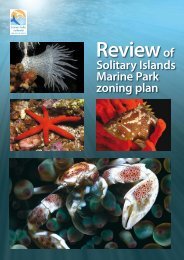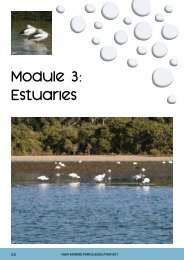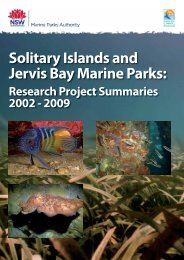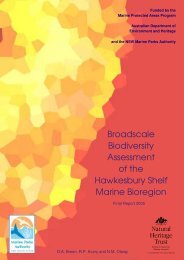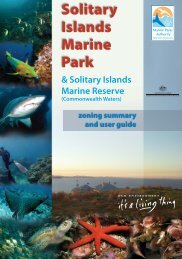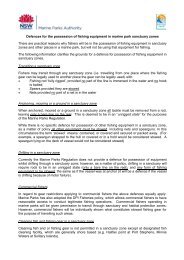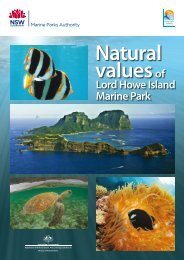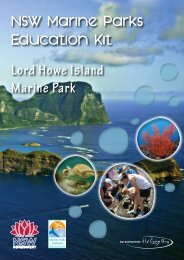Natural values of the Solitary Islands Marine Park - Marine Parks ...
Natural values of the Solitary Islands Marine Park - Marine Parks ...
Natural values of the Solitary Islands Marine Park - Marine Parks ...
- No tags were found...
Create successful ePaper yourself
Turn your PDF publications into a flip-book with our unique Google optimized e-Paper software.
24 <strong>Natural</strong> <strong>values</strong> <strong>of</strong> <strong>the</strong> <strong>Solitary</strong> <strong>Islands</strong> <strong>Marine</strong> <strong>Park</strong>Figure 34.Minnie Waters Lagoon.Figure 35.Ocean beach habitat.Survey results indicate that Flat Top Point has <strong>the</strong>highest relative diversity <strong>of</strong> any coastal rocky shorein <strong>the</strong> marine park (Griffiths 1982, Smith 1988, Smithand Simpson 1991a and b, Smith and James 1999).This site has <strong>the</strong> most sou<strong>the</strong>rly coastal record <strong>of</strong><strong>the</strong> giant clam Tridacna maxima. It is also rich inmolluscs uncommon on o<strong>the</strong>r headlands in <strong>the</strong>marine park such as <strong>the</strong> murex shell Pterotyphisangasi, <strong>the</strong> bubble shell Hydatina physis, <strong>the</strong> flowerstromb Strombus mutabilis, and <strong>the</strong> nudibranchHexabranchus sanguineus or Spanish dancer. O<strong>the</strong>rheadlands in <strong>the</strong> marine park with high speciesdiversity include Station Creek, Diggers Camp–Wilsons Headland, Jones Point,Arrawarra Headland and Woolgoolga Headland (Smith 1988, Smith and James 1999).The rock platform at Sandon Bluff supports lower species diversity than some o<strong>the</strong>rheadlands, but contains unusually dense aggregations <strong>of</strong> gold ring cowries andzoanthids (Smith and James 1999). The enclosed Minnie Waters Lagoon (Figure 34)is <strong>the</strong> only habitat <strong>of</strong> its type in <strong>the</strong> marine park, and along with <strong>the</strong> semi-protectedwaters at Diggers Camp, has a unique reef fish assemblage compared with o<strong>the</strong>r reefs.At sites close to estuary mouths, particularly near barrier lagoons, coastal rocky shorehabitats are important spawning locations for many fish species.4.4 Ocean beachesIn NSW, beaches are ei<strong>the</strong>r intermediate (moderately sloping) or reflective (steeplysloping), depending on <strong>the</strong>ir exposure to waves and swell, which influence <strong>the</strong> type<strong>of</strong> sediments present and <strong>the</strong> presence <strong>of</strong> bars and rips (Short 1993). Some oceanbeaches are interspersed with intertidal and subtidal rocky reefs, which reduce <strong>the</strong>irexposure to swell.There are about 40 sandy beaches ranging from 100 metres to many kilometres longin <strong>the</strong> marine park, from Sandon Beach in <strong>the</strong> North to <strong>Park</strong> Beach at C<strong>of</strong>fs Harbour in<strong>the</strong> south (Figure 35). Sandy beach habitats are naturally dynamic, changing seasonallyas winter storms remove sand from <strong>the</strong> beach, and summer wea<strong>the</strong>r returns sand to<strong>the</strong> beach. Intertidal sandy beach habitats are continuous with, and ecologically linkedto, <strong>the</strong> s<strong>of</strong>t substrate habitats occurring immediately <strong>of</strong>fshore.Different beach types and environments support characteristic assemblages,determined to a large extent by <strong>the</strong> size <strong>of</strong> particles making up <strong>the</strong> sediment. Adiverse range <strong>of</strong> invertebrate species <strong>of</strong>ten occur beneath <strong>the</strong> surface <strong>of</strong> <strong>the</strong> sand,<strong>the</strong> most obvious being <strong>the</strong> macr<strong>of</strong>auna which are dominated by crustaceans,polychaetes and molluscs (Jones and Short 1995).Typical invertebrate macr<strong>of</strong>auna associated withnor<strong>the</strong>rn NSW beaches include isopods (e.g.Pseudolana elegans), amphipods (e.g. Urohaustoriiusgunni) and polychaetes (e.g. Scolelepis normalis)(Hacking 1998). Two <strong>of</strong> <strong>the</strong> more familiar species onsandy beaches are <strong>the</strong> pipi (Donax deltoides) andbeach worms (Family Onuphidae) as <strong>the</strong>y are <strong>of</strong>tencollected for bait by recreational anglers.



